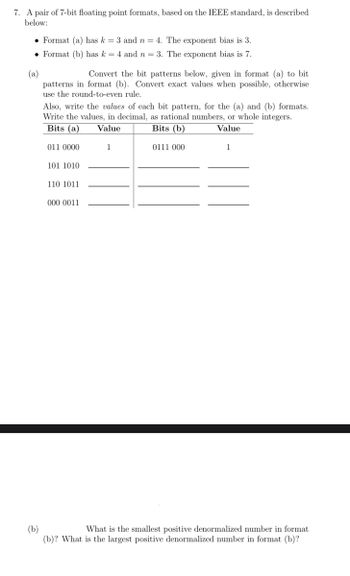
Database System Concepts
7th Edition
ISBN: 9780078022159
Author: Abraham Silberschatz Professor, Henry F. Korth, S. Sudarshan
Publisher: McGraw-Hill Education
expand_more
expand_more
format_list_bulleted
Question

Transcribed Image Text:7. A pair of 7-bit floating point formats, based on the IEEE standard, is described
below:
• Format (a) has k = 3 and n = 4. The exponent bias is 3.
Format (b) has k = 4 and n = 3. The exponent bias is 7.
(a)
Convert the bit patterns below, given in format (a) to bit
patterns in format (b). Convert exact values when possible, otherwise
use the round-to-even rule.
Also, write the values of each bit pattern, for the (a) and (b) formats.
Write the values, in decimal, as rational numbers, or whole integers.
Bits (a) Value
Bits (b)
Value
1
0111 000
011 0000
101 1010
110 1011
000 0011
1
(b)
What is the smallest positive denormalized number in format
(b)? What is the largest positive denormalized number in format (b)?
Expert Solution
This question has been solved!
Explore an expertly crafted, step-by-step solution for a thorough understanding of key concepts.
Step by stepSolved in 3 steps

Knowledge Booster
Learn more about
Need a deep-dive on the concept behind this application? Look no further. Learn more about this topic, computer-science and related others by exploring similar questions and additional content below.Similar questions
- 1. Convert the following decimal numbers into their IEEE-754 single-precision (32-bit) representations. Give your answers in hexadecimal form. All intermediate steps must be clearly shown. A single result will not receive marks a. 655.34375 b. -1.875 c. 0.734375arrow_forward5arrow_forwardUsing the SEC-DED Hamming code given in class (for 4 bit words), determine whether there is no error, an error in one bit, or an error in two bits for the following 8 bit word fetched from memory. If there is an error in one bit, indicate which bit is in error. 0011 1011arrow_forward
- Assume that a system uses 10-bit floating-point representation based on the IEEE floating-point format, in which: . There is 1 sign bit. There are k= 6 exponent bits. The exponent bias is 31. . There are n= 3 fraction bits. ● Convert the decimal number -5.5 into the 10-bit IEEE floating point representation explained above. Write the final result in 10-bit binary format. Show your steps.arrow_forward2. Assume we are using the simple model for floating-point representation as given in this book (the representation uses a 16-bit format, 5 bits for the exponent with a bias of excess-15, a normalized mantissa of 10 bits, and a single sign bit for the number): Show how the computer would represent the numbers a) +3.53125 and -3.34375 using this floating-point format. a) +3.53125 b)-0.09375arrow_forward7. Add the following two 8-bit binary numbers, producing an 8-bit result. Indicate the status of the carry and overflow bits at the end of the addition by circling the appropriate choices. The space in between is only for readability. 1101 0110 + 1001 0111 -------------- Overflow? Yes or No Carry? Yes or Noarrow_forward
- Are you able to differentiate between the least significant bit and the most significant bit in a given set of data?arrow_forwardWrite down the bit pattern in the fraction assuming a fl oating point format that uses Binary Coded Decimal (base 10) numbers in the fraction instead of base 2. Assume there are 24 bits, and you do not need to normalize. Is this representation exact?arrow_forwardIn single precision (IEEE-754 standard), 8 bits are used for storing the exponent (the bias is 127), and 23 bits are used for storing the mantissa. (a) What are the smallest and the largest positive numbers that can be stored in single precision? (b) What is the smallest value of the mantissa that can be stored?arrow_forward
- 1 a. If the last operation performed on a computer with an 8-bit word was an addition in which the two operands were 00000010 and 00000011, what would be the value of the following flags? ● Carry • Zero • Overflow Sign • Even Parity ● Half-Carry b. Repeat for the addition of -1 (twos complement) and +1.arrow_forward6. Using IEEE 754 representation for single precision floating point, give the 32-bit binary encoding for the numbers below. Show the sign, exponent, and mantissa (significand).b. 11.2265625arrow_forwardCan please help with part a and b and show workarrow_forward
arrow_back_ios
SEE MORE QUESTIONS
arrow_forward_ios
Recommended textbooks for you
 Database System ConceptsComputer ScienceISBN:9780078022159Author:Abraham Silberschatz Professor, Henry F. Korth, S. SudarshanPublisher:McGraw-Hill Education
Database System ConceptsComputer ScienceISBN:9780078022159Author:Abraham Silberschatz Professor, Henry F. Korth, S. SudarshanPublisher:McGraw-Hill Education Starting Out with Python (4th Edition)Computer ScienceISBN:9780134444321Author:Tony GaddisPublisher:PEARSON
Starting Out with Python (4th Edition)Computer ScienceISBN:9780134444321Author:Tony GaddisPublisher:PEARSON Digital Fundamentals (11th Edition)Computer ScienceISBN:9780132737968Author:Thomas L. FloydPublisher:PEARSON
Digital Fundamentals (11th Edition)Computer ScienceISBN:9780132737968Author:Thomas L. FloydPublisher:PEARSON C How to Program (8th Edition)Computer ScienceISBN:9780133976892Author:Paul J. Deitel, Harvey DeitelPublisher:PEARSON
C How to Program (8th Edition)Computer ScienceISBN:9780133976892Author:Paul J. Deitel, Harvey DeitelPublisher:PEARSON Database Systems: Design, Implementation, & Manag...Computer ScienceISBN:9781337627900Author:Carlos Coronel, Steven MorrisPublisher:Cengage Learning
Database Systems: Design, Implementation, & Manag...Computer ScienceISBN:9781337627900Author:Carlos Coronel, Steven MorrisPublisher:Cengage Learning Programmable Logic ControllersComputer ScienceISBN:9780073373843Author:Frank D. PetruzellaPublisher:McGraw-Hill Education
Programmable Logic ControllersComputer ScienceISBN:9780073373843Author:Frank D. PetruzellaPublisher:McGraw-Hill Education

Database System Concepts
Computer Science
ISBN:9780078022159
Author:Abraham Silberschatz Professor, Henry F. Korth, S. Sudarshan
Publisher:McGraw-Hill Education

Starting Out with Python (4th Edition)
Computer Science
ISBN:9780134444321
Author:Tony Gaddis
Publisher:PEARSON

Digital Fundamentals (11th Edition)
Computer Science
ISBN:9780132737968
Author:Thomas L. Floyd
Publisher:PEARSON

C How to Program (8th Edition)
Computer Science
ISBN:9780133976892
Author:Paul J. Deitel, Harvey Deitel
Publisher:PEARSON

Database Systems: Design, Implementation, & Manag...
Computer Science
ISBN:9781337627900
Author:Carlos Coronel, Steven Morris
Publisher:Cengage Learning

Programmable Logic Controllers
Computer Science
ISBN:9780073373843
Author:Frank D. Petruzella
Publisher:McGraw-Hill Education